Exploring Forces NCERT Solutions | Science Curiosity Class 8 - New NCERT PDF Download
| Table of contents |

|
| Probe and Ponder (Page 61) |

|
| InText (Page 67 - 76) |

|
| Keep the curiosity alive (Page 77) |

|
| Discover, design, and debate (Page 79) |

|
Probe and Ponder (Page 61)
Q1. Why does it feel harder to pedal a bicycle when going uphill than on flat ground?
Ans: When cycling uphill, a bicycle has to move against gravity, which pulls both the cycle and the rider downward. More muscular force has to be applied to push the bicycle up the slope as compared to flat ground, where gravity does not resist the forward motion as much. That is why pedaling feels much harder going uphill.
Q2. Why is it easier to slip on a wet surface?
Ans: Wet surfaces have less friction compared to dry surfaces. Friction is the force that helps in gripping the ground when walking or moving. When a surface is wet, the thin layer of water reduces the irregularities between the surfaces of shoes and the floor, causing the friction to decrease. With less friction, it is easy to slip and fall.
Q3. Why do we feel ‘light’ or like we are ‘floating’ just after our swing reaches its highest point and begins to come down?
Ans: When a swing reaches its highest point, the swing momentarily slows down before starting to move back. At that instant, the downward pull of gravity is almost balanced by the swing’s support, which reduces the normal force acting on our body. This reduction in normal force makes us feel “light” or as if we are floating for a brief moment. Q4. Share your questions ____________
Q4. Share your questions ____________
Ans:
- Why does sliding work better on ice than on sand?
- What would happen if friction did not exist at all?
- Why do heavier objects sink more in water than lighter ones of the same size?
- Does air also provide friction to moving objects?
- Why can some birds fly easily for long periods without getting tired?
InText (Page 67 - 76)
Q1: Is there any other contact force? (Page 67)
Ans: Yes. Other examples of contact forces include the force of friction and the normal force. These forces act when objects are in direct contact.
Q2: Is it essential for an object applying force on another object to always be in contact with it? (Page 69)
Ans: No. Forces can be applied either through direct contact (contact forces) or without direct contact (non-contact forces), such as gravitational or magnetic forces.
Q3: Does it mean that there are two kinds of electrical charges? (Page 71)
Ans: Yes. There are two types of electric charge: positive and negative. These are fundamental properties of matter.
Q4: Why do all the objects fall towards the Earth? (Page 72)
Ans: Objects fall towards the Earth because of gravity, a force of attraction between objects with mass. Near the Earth, this force causes all objects to accelerate downward at the same rate (approximately 9.8 m/s²), regardless of their mass.
Q5: Is there any force that acts on them? What exerts this force? (Page 72)
Ans: Yes, gravity acts on all objects. The Earth, due to its large mass, exerts a gravitational force on objects near it, pulling them toward its center.
Q6: Does the Earth pull every object with equal force? (Page 72)
Ans: No. The Earth pulls heavier objects with a greater gravitational force than lighter objects. However, the acceleration due to gravity is the same for all objects near Earth’s surface, so they fall at the same rate (ignoring air resistance).
Q7: What is the difference between weight and mass? (Page 75)
Ans: Mass is the amount of matter in an object and does not change with location. Weight is the force exerted on an object due to gravity. On Earth, weight and mass are proportional, but weight depends on the strength of gravity.
Q8: If we place some objects on water, some of them float, while others fall to the bottom. The gravitational force of the Earth is acting on all objects, so why don’t all objects fall to the bottom? (Page 76)
Ans: Although gravity acts on all objects, whether they float or sink depends on the buoyant force and the object’s density compared to water. Objects less dense than water float because the buoyant force is stronger than their weight, while denser objects sink because gravity overcomes the buoyant force.
Keep the curiosity alive (Page 77)
Q1: Match items in Column A with the items in Column B.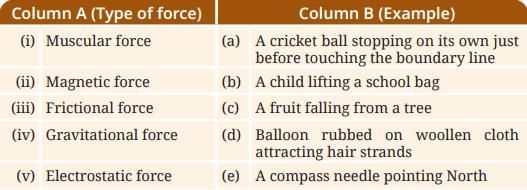
Ans: 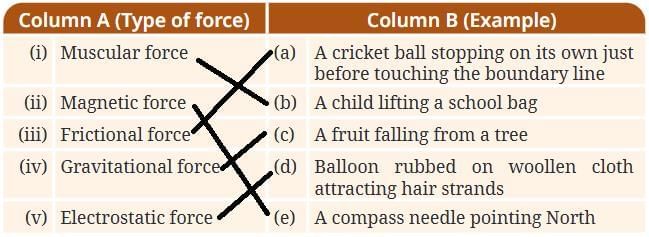
Q2: State whether the following statements are True or False.
(i) A force is always required to change the speed of motion of an object.
Ans: True
A force is indeed always required to change the speed of motion of an object. If there is no force acting on an object, it will maintain its current speed and direction (unless it’s already at rest, in which case it will stay at rest).
(ii) Due to friction, the speed of the ball rolling on a flat ground increases.
Ans: False
Friction opposes motion, so it will decrease the speed of a rolling ball.
(iii) There is no force between two charged objects placed at a small distance apart.
Ans: False
There is a force between charged objects. This force can be attractive or repulsive depending on the charges. But it is always present when charges are close to each other.
Q3: Two balloons rubbed with a woollen cloth are brought near each other. What would happen and why?
Ans: When two balloons are rubbed with a woollen cloth and brought near each other, they will repel each other. This happens because both balloons will acquire a negative charge when rubbed with wool, and like charges repel.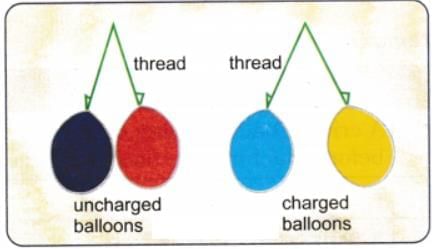
Q4: When you drop a coin in a glass of water, it sinks, but when you place a bigger wooden block in water, it floats. Explain.
Ans: A coin sinks in water because its density (mass per unit volume) is greater than that of water. A wooden block floats because its density is less than that of water, causing it to be buoyed up by the water.
Q5: If a ball is thrown upwards, it slows down, stops momentarily, and then falls back to the ground. Name the forces acting on the ball and specify their directions.
(i) During its upward motion
(ii) During its downward motion
(iii) At its topmost position
Ans: When a ball is thrown upwards, the only force acting on it throughout its entire motion is gravity, which pulls it downwards. However, depending on the motion of the ball, the direction of this force relative to the ball’s velocity changes.
(i) During its upward motion: The force of gravity is downwards, opposing the upward motion of the ball, causing it to slow down.
(ii) During its downward motion: The force of gravity is still downwards, but now it aligns with the ball’s direction of motion, accelerating it downwards.
(iii) At its topmost position: The ball has zero velocity, meaning it’s momentarily stationary. At this point, the force of gravity is still downwards, but since the ball is not moving upwards or downwards, it has no net effect on the ball’s motion.
Q6: A ball is released from the point P and moves along an inclined plane and then along a horizontal surface as shown in the Fig. 5.16. It comes to stop at the point A on the horizontal surface. Think of a way so that when the ball is released from the same point P, it stops
(i) before the point A
(ii) after crossing the point A. Ans: The ball’s motion is governed by the forces of gravity and friction. On the inclined plane, gravity provides the acceleration for the motion. On the horizontal surface, only friction acts on the ball.
Ans: The ball’s motion is governed by the forces of gravity and friction. On the inclined plane, gravity provides the acceleration for the motion. On the horizontal surface, only friction acts on the ball.
(i) Stopping before A: Increasing friction on the horizontal surface will cause the ball to decelerate more rapidly, meaning it will come to a stop sooner, potentially before reaching point A.
(ii) Stopping after A: Decreasing friction on the horizontal surface will reduce the deceleration, allowing the ball to travel further before losing all its kinetic energy and stopping.
Q7: Why do we sometimes slip on smooth surfaces like ice or polished floors? Explain.
Ans: When we walk on surfaces like ice, we often slip, which means we lose our balance and fall. This happens because the force that helps us stay upright and move forward (friction) is not enough. These surfaces have fewer irregularities. Minimizing the contact area and the force of friction between the surface and our shoes makes it easier to slide instead of grip. A layer of water, even a thin one on ice, can further reduce friction by acting as a lubricant, making the surface even more slippery.
Q8: Is any force being applied to an object in a non-uniform motion?
Ans: Yes, for an object to be in non-uniform motion, a force must be acting upon it. Non-uniform motion, also known as accelerated motion, means the object’s velocity is changing, either in speed or direction, or both. This change in velocity requires a force to be applied.
Q9: The weight of an object on the Moon becomes one-sixth of its weight on the Earth. What causes this change? Does the mass of the object also become one-sixth of its mass on the Earth?
Ans: The change in an object’s weight on the moon compared to Earth is due to the difference in gravitational force. The moon’s gravity is significantly weaker than Earth’s, roughly one-sixth as strong. However, the mass of an object remains the same regardless of location; only weight changes with gravitational pull.
Q10: Three objects 1, 2, and 3 of the same size and shape but made of different materials are placed in water. They dip to different depths as shown in Fig. 5.17. If the weights of the three objects 1, 2, and 3 are w1, w2, and w3, respectively, then choose the correct relation.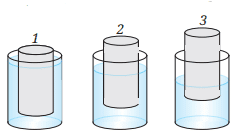 Fig.5.17
Fig.5.17
(i) w1 = w2 = w3
(ii) w1 > w2 > w3
(iii) w2 > w3 > w1
(iv) w3 > w1 > w2
Ans: (ii) The relationship between the weights of the objects is w1 > w2 > w3
Object 1 is the deepest meaning it displaces the most water.
Object 2 is less deep than object 1 but deeper than object 3.
Object 3 is the least deep, meaning it displaces the least amount of water.
Since the objects have the same size and shape, the greater the depth, the greater the weight of the object (assuming they are all made of the same material).
Hence, the object with the greatest weight will sink the deepest, and the object with the least weight will be the closest to the surface.
Discover, design, and debate (Page 79)
Q1: Collect objects made of different materials, such as plastic, wool, silk, rubber, polythene sheet, paper, and metals. Rub one material with another and check if it attracts small pieces of paper or not, that is, whether it gets charged or not. Record your observations in a systematic manner and write a research paper.
Ans: Collecting and Rubbing Materials: Research on Electrostatic Charging
Experiment Steps:
- Gather materials: plastic scale, wool, silk cloth, rubber balloon, polythene sheet, paper, and metals like an iron key or a coin.
- Rub one material (for example, a plastic scale) with another material (like wool or silk).
- Bring the rubbed object close to small pieces of paper and observe if they are attracted.
Observation Table Example:
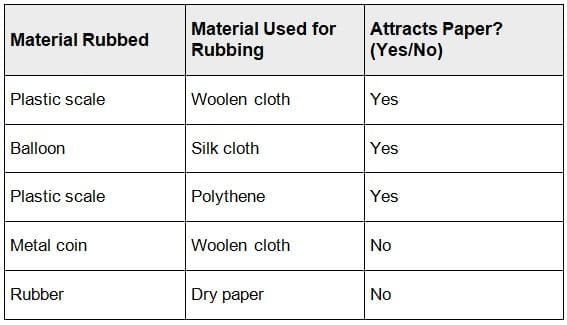
Conclusion: Objects made of plastic, wool, or silk become electrically charged when rubbed together and can attract small pieces of paper. Metals usually do not get charged in this way. This is because some materials transfer electrons when rubbed, creating static electric charges.
Q2: Imagine a scenario where the gravity disappears. Develop a story. Create a cartoon strip to present your story. z Organise a discussion in your class on the topic: Friction—a necessity or a problem? Make a note of the discussion and state where friction is a necessity and when it is a problem.
Ans:
Story: One morning, everyone wakes up to find that gravity has vanished! The moment a ball is thrown, it rises up and never comes down. People start floating off their beds and must grab tightly to the doors and furniture. Water in glasses begins to float around in little blobs, and food hovers above plates. Birds try to fly but end up floating higher and higher. Cars and cycles no longer grip the road, and everyone must wear heavy boots to avoid floating away. Animals and plants on Earth start floating as well. Without gravity, life becomes very difficult, and people must come up with clever ways to stay on the ground or inside their houses.
Cartoon Strip:
- Panel 1: A boy throws a ball and it floats up, surprised expression!
- Panel 2: Breakfast cereal and milk floating in the air in a kitchen.
- Panel 3: The family tying themselves to the sofa to watch TV.
- Panel 4: A cat and dog floating among furniture, while the phone, keys, and homework papers hover around.
Q3: Organise a discussion in your class on the topic: Friction—a necessity or a problem? Make a note of the discussion and state where friction is a necessity and when it is a problem.
Ans:
Necessity:
- Friction helps us walk without slipping.
- Allows cars, bicycles, and buses to move and stop safely.
- Needed to write with a pencil or pen.
- Helps in holding and gripping objects.
Problem:
- Friction wastes energy as heat (machines get hot).
- Causes wear and tear of parts in machines, shoes, and tires.
- Makes it harder to move heavy objects.
Conclusion: Friction is necessary in daily life for grip and safety, but too much friction can make tasks difficult and can damage objects or waste energy.
Q4: Make your own spring balance with the help of your teacher and calibrate it using standard weights. Now measure the weights of different objects and calculate the ratio of the weight and mass of different objects. Do you observe a pattern?
Ans: Steps:
- Create a spring balance with help from a teacher, calibrate it using known weights (like 100g, 200g).
- Hang objects (eraser, pencil box, water bottle, stone) and note their weights.
- Measure the mass of the same objects using a digital or beam balance.
Table:

Pattern: The ratio of weight to mass is nearly the same for all objects (about 0.01N/g), showing that weight depends on mass and gravity.
Q5: An electroscope is a device which can determine whether an object is electrically charged. You can make your own electroscope (Fig. 5.18) in your class with the help of your teacher, test the device. Explore in what other ways you may use this electroscope.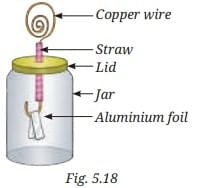 Ans: Steps to Make an Electroscope
Ans: Steps to Make an Electroscope
- Use a clean, dry jar with a plastic or cardboard lid.
- Insert a metal wire through the lid; attach thin strips of aluminium foil to the inside end of the wire.
- Charge a plastic scale by rubbing with wool, then bring it close to the exposed end of the wire.
Observation: When a charged object is brought near the wire, the aluminium strips repel each other and move apart. This indicates the presence of an electric charge.
Other Uses:
- To check if an object is electrically charged or not.
- Can be used to show that charges can transfer from one object to another.
- Can help detect static electricity in different classroom experiments.
|
59 videos|236 docs|13 tests
|
FAQs on Exploring Forces NCERT Solutions - Science Curiosity Class 8 - New NCERT
| 1. What are the different types of forces discussed in Class 8 NCERT textbook? |  |
| 2. How does frictional force affect the motion of objects? |  |
| 3. Can you explain the concept of gravitational force with an example? |  |
| 4. What is the significance of balanced and unbalanced forces in everyday life? |  |
| 5. How can we calculate the net force acting on an object? |  |





















